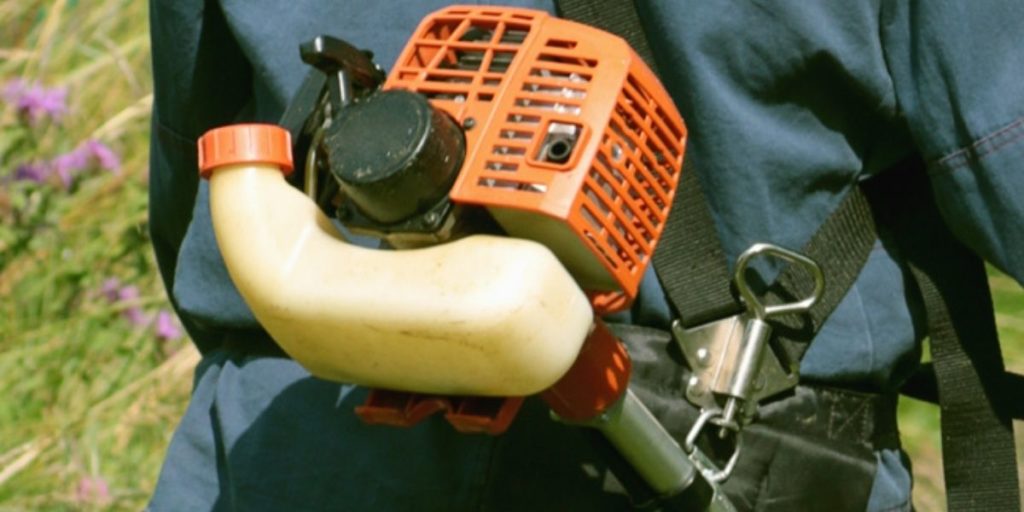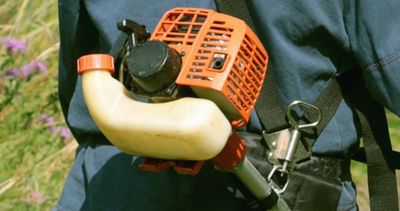A string trimmer helps finish up the well-manicured look of your yard. You use it to cut grass left behind that your mower can’t cover. This includes areas around flower beds, fence posts, landscaping and water features.
Without a string trimmer, your yard won’t achieve that “finished” appearance you strive for. It’s one of those tools you prefer not to live without. So, when your string trimmer no longer gives you the power you are used to, it’s time to take a look at an airflow, fuel flow or spark problem.
Why a string trimmer has no power:
- Old gasoline
- Plugged air filter
- Dirty spark plug
- Plugged fuel filter
- Clogged fuel line
- Plugged fuel tank vent
- Plugged spark arrestor
- Carbon buildup on the exhaust port
- Dirty carburetor

This post may include affiliate links. Purchases made through these links may provide a commission for us, at no extra cost to you. As an Amazon Associate, we earn from qualifying purchases.
Follow all safety instructions provided in your equipment operator’s manual prior to diagnosing, repairing, or operating.Consult a professional if you don’t have the skills, or knowledge or are not in the condition to perform the repair safely.
8 Reasons a String Trimmer Has No Power
Old Gasoline in a String Trimmer
Over time gasoline can break down and cause running problems in a string trimmer. Using old fuel can cause fuel restrictions and damage to the carburetor and engine. Most types of gasoline include ethanol, a corn-based fuel, added to make gasoline a little more environmentally friendly.
Ethanol is not good for the small engine used in a string trimmer. It attracts moisture which is corrosive to the fuel system and creates gummy deposits that can clog the fuel system. These deposits can prevent fuel from flowing through the fuel lines and cause the carburetor to fail.
Because of the harmful effects of ethanol on your trimmer, it is best to use mid-grade unleaded gasoline with an octane rating of 89 and a maximum ethanol content of 10% (E10).
Never use types of gasoline with higher ethanol contents like E15, E30, and E85 fuels. Read more about the right fuel for your 2-cycle or 4-cycle string trimmer in This is the Type of Gas and Oil String Trimmers Use.
Solution: Drain the oil fuel remaining in your string trimmer and fill it with fresh fuel. A 2-cycle engine requires an oil and fuel mix. A 4-cycle engine requires unleaded gasoline with an ethanol content of less than 10%.
Plugged Air Filter in a String Trimmer
Your string trimmer requires sufficient air to keep running. When the airflow is restricted, you will lose power to the trimmer.
Remove the air filter cover, usually held on with 4 screws. Remove the filter and wipe out any remaining dirt and debris from the housing. Check the air filter for a buildup of dirt plugging the filter and not allowing a good flow of air to pass through it.
Solution: If you find your air filter is plugged, I recommend replacing the filter. A filter is usually not very expensive. It is an important component when it comes to protecting the engine.
A foam, fabric, or felt-style filter can be cleaned using mild dish soap and water. Wash the filter to remove as much dirt as possible. Rinse until clear.
A paper filter can be cleaned by knocking it against a solid surface to remove as much dirt as possible. Hold it up to a light source to see if you can see light through the element.
Reuse the filter if you can still see light. Replace the filter if you cannot see light, your filter is very dirty or it is covered in oil.
Dirty Spark Plug in a String Trimmer
A spark plug can cause your string trimmer to lose power when it is fouled or damaged. A spark plug that is excessively dirty or incorrectly gapped will make a bad connection.
Solution: Remove the spark plug and replace the spark plug when you find it is dirty or damaged. Make sure the new spark plug is gapped to the manufacturer’s specification.
It is possible to clean a spark plug using a wire brush if it isn’t very dark in color. Again, I prefer to replace this maintenance item as the spark plug is a vital component of a well-running string trimmer.
Plugged Fuel Filter in a String Trimmer
The fuel filter is located off the fuel line found in the fuel tank. The filter is responsible for straining the fuel to prevent dirt and debris from entering the fuel system.
When the fuel filter becomes clogged, a loss of power may be experienced because of the lack of fuel in the engine.
Solution: Replace a fuel filter that isn’t allowing gas to pass through it and into the fuel line. Check your fuel tank to make sure the fuel is of good quality and is not contaminated with dirt and debris.
Clogged Fuel Line in a String Trimmer
The fuel line can become restricted with gummy deposits left behind from using old fuel through your string trimmer. Dirt could have also gotten into the fuel system causing blockages. This can prevent a good flow of fuel to the engine resulting in power loss.
Solution: Inspect the fuel line looking for any clogs preventing fuel flow. Replace a fuel line that is clogged, kinked, or has developed cracks from age.
Plugged Fuel Tank Vent on a String Trimmer
The fuel tank must be vented to equalize the air pressure in the tank. When there isn’t a vent, the tank will form a vacuum and won’t allow fuel to flow out of the tank.
Your string trimmer model may use a tank vent connected to the fuel line or it may have a vent built into the fuel cap.
Solution: If your string trimmer begins to bog down and lose power, loosen or remove the cap while the string trimmer sits level to avoid spilling fuel.
If your trimmer no longer runs sluggish and loses power once the air is introduced to the fuel tank, you most likely have a plugged fuel tank vent.
Determine which type of vent you have on your string trimmer and replace it. It may be a fuel tank vent off the fuel line coming out of the fuel tank or in the fuel tank cap.
Plugged Spark Arrestor in a String Trimmer
The spark arrestor is a small metal screen that prevents hot exhaust material from leaving the muffler and starting a fire. When this small screen becomes plugged you may experience a loss of power where your string trimmer won’t run at full RPMs.
Solution: Disconnect the spark plug wire. Remove the engine cover and the engine exhaust cover. Carefully remove the spark arrestor screen. Clean it with a wire brush and reinstall it.
If the screen isn’t able to be sufficiently cleaned or you find it is damaged or has a hole in it, replace it with a new spark arrestor screen.
Carbon Buildup on the Exhaust Port in a String Trimmer
The exhaust port located behind the muffler can develop carbon deposits that can cause your string trimmer running problem. This area should be checked and cleaned.
Solution: Start by disconnecting the spark plug wire. Once this is done proceed with removing the engine cover, the muffler, and the heat shield. Adjust the piston until it covers the port opening.
This will keep carbon from falling into the cylinder. You do not want carbon getting in the cylinder.
Use a plastic scraper to remove the carbon buildup around the exhaust port. DO NOT use a metal tool. Do not scratch the piston or the cylinder during this process.
Dirty Carburetor in a String Trimmer
The carburetor regulates the amount of fuel that is mixed with air to create combustion in the cylinder. Old fuel will gum up and clog the carburetor so it no longer functions properly.
Solution: If you are a little mechanical you should be able to handle cleaning your carburetor. Clean the carburetor by taking it apart and using carburetor cleaner to clean it.
If the carburetor does not function after being cleaned, you may need to rebuild it or replace it with a new carburetor.
Carburetors for a string trimmer can run between $60-$140 depending on the manufacturer of your string trimmer.
Depending on the model string trimmer you run and the price of the carburetor, it may be best to invest in a new string trimmer rather than put money towards replacing a carburetor on an old trimmer.
When to Have a Mechanic Repair Your String Trimmer?
You may have gone through the items above and it didn’t solve your trimmer’s lack of power. You may just not feel comfortable performing repairs on your string trimmer. That’s okay.
Find a small engine mechanic or an outdoor power equipment store that has a repair shop to assist you.
Keep in mind the labor rate for the mechanic to diagnose your problem. There is typically a flat rate charge to diagnose the problem and then add labor and parts fees in addition to the fee to make the repairs.
This may not make sense if you are running an old inexpensive string trimmer that’s on its last leg. I just like to remind you of this as I’ve experienced many surprised customers who found out the repair will cost more than the purchase of their inexpensive string trimmer.
Having your string trimmer repaired by a mechanic is a personal decision that only you can make. You have the weigh the reliability, quality, and age of your current string trimmer against the cost to repair it and the cost to purchase a new string trimmer.
